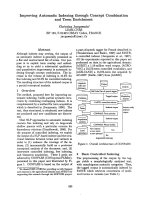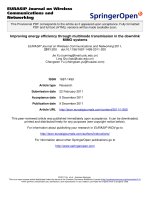Improving force control through end effector vibration reduction and variable stiffness joint design
Bạn đang xem bản rút gọn của tài liệu. Xem và tải ngay bản đầy đủ của tài liệu tại đây (2.62 MB, 108 trang )
IMPROVING FORCE CONTROL THROUGH END-
EFFECTOR VIBRATION REDUCTION AND VARIABLE
STIFFNESS JOINT DESIGN
LI RENJUN
NATIONAL UNIVERSITY OF SINGAPORE
2014
IMPROVING FORCE CONTROL THROUGH END-
EFFECTOR VIBRATION REDUCTION AND VARIABLE
STIFFNESS JOINT DESIGN
LI RENJUN
(B.Eng. (Hons.), NUS)
A THESIS SUBMITTED
FOR THE DEGREE OF DOCTOR OF PHILOSOPHY
DEPARTMENT OF MECHANICAL ENGINEERING
NATIONAL UNIVERSITY OF SINGAPORE
2014
DECLARATION
I hereby declare that the thesis is my original work and it has been written by me in
its entirety. I have duly acknowledged all the sources of information which have been
used in the thesis.
This thesis has also not been submitted for any degree in any university previously.
_______ __________
Li Renjun
08 January 2014
i
Acknowledgements
I would like to express my most sincere gratitude to my supervisor, Associate
Professor Chew Chee-Meng for his patience and valuable guidance during the
course of my Ph.D. study. His depth of knowledge, insight and untiring work
ethic has been and will continue to be a source of inspiration to me.
I would also like to thank the staffs in Singapore Institute of Manufacturing,
particularly Dr. Lim Chee Wang, Dr. Vuong Ngoc Dung and Dr. Li Yuanping
for their support and help during my study. I want to thank them for their
motivation, support, and critique about the work.
I have also benefitted from discussion with many of seniors and colleagues. In
particular Wu Ning, Shen Bingquan, Tan Boon Hwa and others in the Control
and Mechatronics Lab.
I also would like to thank National University of Singapore for offering me
research scholarship and research facilities. I benefitted from the abundant
professional books and technical Journal collection at NUS library.
Finally, I would like to devote the thesis to my family for their love and
understanding.
ii
Table of Content
Acknowledgements i
Table of Content ii
Summary v
List of Table vii
List of Figures vii
Chapter 1 Introduction 1
1.1 Background 1
1.2 Research Objective and Contributions 3
1.3 Organizations of the Thesis 5
Chapter 2 Literature Review 6
2.1 Active Interaction Control 7
2.2 Force Control Using Series Macro-Mini Manipulation 9
2.3 Force Control Actuators 11
2.3.1 Series Elastic Actuator (SEA) 11
2.3.2 Parallel Actuation 13
2.3.3 Series Damper Actuator (SDA) 14
2.3.4 Variable Stiffness Actuator (VSA) 14
2.3.4.1 Variable Stiffness Mechanism Based on Pretension Non-
linear Spring 15
2.3.4.2 Variable Stiffness Mechanism Based on Antagonistic
Actuation 16
2.3.4.3 Variable Stiffness Mechanism Based on Adjustable
Mechanical Structure 17
iii
2.4 Summary 19
Chapter 3 Force Control Using Serial Macro-Mini Manipulator System 20
3.1 Introduction 20
3.2 Modeling of Series Macro Mini Manipulator Systems 22
3.2.1 Lumped Mass-Spring-Damper Representation 23
3.2.2 Block Diagram Representation 23
3.3 Zero Coupling Impedance: A Controller to Suppress Vibration from
Contact Point 27
3.3.1 Vibration during Force Control 27
3.3.2 Zero Coupling Impedance Criterion 31
3.3.3 Verification of Zero Coupling Impedance Criterion 33
3.3.3.1 System Identification 34
3.3.3.2 Simulation Study 36
3.3.3.3 Experiment Study 39
3.3.4 Controller Design for Force Control 41
3.4 Zero Coupling Impedance: A Design Guideline for Series Macro-
Mini System 45
3.5 Summary 48
Chapter 4 A New Variable Stiffness Joint for Force Control 50
4.1 Introduction 50
4.2 Design Requirements 51
4.2.1 Linear Passive Load-Displacement Relationship 52
4.2.2 Adjustable Stiffness Ranging from Zero to Infinity 54
4.2.3 High Resolution in Low Stiffness Range 55
4.3 Working Principle 55
iv
4.3.1 Lever Arm Mechanism without Constrained Ends 56
4.3.2 Lever Arm Mechanism with Constrained Ends 57
4.4 Mechanical Design 62
4.5 Characteristics of the Joint 63
4.5.1 Key Parameters 63
4.5.2 Joint Deflection Range 65
4.5.3 Stiffness Characteristic 66
4.5.4 Characteristics Identification 67
4.5.5 Output Frequency Response 73
4.6 Force Control Using the Joint 75
4.6.1 Controller Design 75
4.6.2 Searching for Contact Experiment 77
4.7 Summary 82
Chapter 5 Conclusion 83
5.1 Summary of Results 83
5.2 Significance of the Research 85
5.3 Limitations and Recommendations for Future Research 86
Bibliography 88
Appendix: Controller Design for Decoupled Mini Manipulator 93
v
Summary
In this thesis, the author proposed two approaches to improve robotic force
control performance. Two commercially recognized force control methods
were studied and solutions were proposed to resolve the issues in these two
methods.
Conventional manipulators typically are designed for repetitively position
controlled applications. They are normally constructed using transmission
systems, such as gears, to increase the load capacity and position accuracy.
Their large inertia and non-back-drivability due to the transmission system
make the robots very sensitive to disturbances, especially at high frequencies.
In many applications, high frequency disturbances are inevitable due to the
relative motion between the end-effector and the environment. Therefore, this
research is aimed to study various ways of improving the force control
performance.
In this thesis, the author constructed a dynamic model to analyze robotic force
control. Two approaches of improving the performance from both manipulator
level and joint level were explored in this thesis.
The first method of improving force control performance from the manipulator
level involves using a conventional manipulator to carry a high performance
end-effector. However, internal vibration has been found in such a system
despite of its good performance. Thus, a design and control guideline named
Zero Coupling Impedance criterion has been proposed to handle the vibration.
The Zero Coupling Impedance criterion aims to decouple the high
performance mini manipulator from the conventional macro manipulator so
that the performance of the mini will not be limited by the macro.
vi
The second method aims to modify the conventional manipulator design from
joint level such that it is suitable for force control. However, many existing
variable stiffness joints have non-linear load-displacement relationship, which
tends to induce relatively large contact force when high frequency disturbance
presents. Therefore, a new variable stiffness joint has been proposed to
address the problem. Theoretically, the novel variable stiffness joint has a
linear load-displacement relationship, with stiffness ranged from zero to
infinity. This guarantees that the joint mechanism could be widely used in all
types of applications. Furthermore, designing controller for the proposed
variable stiffness actuator can be easy since the system can be a linear system.
Simulation and experiments were performed to verify the effectiveness of the
proposed methods. A Mitsubishi PA-10 robot and a linear voice coil actuator
were used to form a series macro-mini manipulator. The force control
performance during grinding showed that the Zero Coupling Impedance
criterion is effective in suppressing the vibration in a series macro-mini
manipulator system. Furthermore, a variable stiffness joint using level
mechanism has been built and tested. Experiments have shown that the novel
variable stiffness joint design using a lever arm mechanism with constrained
ends successfully decoupled the stiffness from the output load.
In conclusion, this thesis has provided two approaches to improve force
control performance. The Zero Coupling Impedance criterion could be used to
improve the performance of a series macro-mini manipulator while the novel
joint design provided a possibility to build a new generation manipulator using
compliant joint mechanism.
vii
List of Table
Table 4.1: Key Parameters of the Joint 64
List of Figures
Figure 2.1: Impedance control [1] 8
Figure 2.2: Hybrid position/force control [2] 8
Figure 2.3: Concept of series macro-mini manipulator system[40] 10
Figure 2.4: Series Elastic Actuator (SEA) [50, 51] 12
Figure 2.5: (a) Parallel Coupled Macro-Mini manipulator [52]; (b) Parallel-
Distributed actuation [53] 13
Figure 2.6: Series Damper Actuator (SDA) [13] 14
Figure 2.7: (a) Variable stiffness mechanism DLR-VS [54]; (b) Mechanical
for Varying Stiffness via changing Transmission ANgle (MESTRAN) [55] 15
Figure 2.8: (a) Prototype of VSA [57]; (b) Prototype of VSA-II [56]; (c)
Quadratic series-elastic actuation [58]; (d) DLR Floating Spring Joint [61] 16
Figure 2.9: (a) CAD drawing of variable stiffness joint using leaf spring [62];
(b) CompAct-VSA [64]; (c) AwAS-II [65]; (d) working principle of HDAU
[66] 18
Figure 3.1: A series macro mini system 22
Figure 3.2: Modeling of series macro mini manipulator using lumped mass-
spring-damper 23
Figure 3.3: (a) Single block of mass-spring-damper block; (b) block diagram
representation of the single block of mass-spring-damper block 24
Figure 3.4: Block diagram represented using impedance and admittance 24
Figure 3.5: (a) two mass-spring-damper blocks in series; (b) block diagram
representation 25
viii
Figure 3.6: (a) n mass-spring-damper blocks in series; (b) block diagram
representation 25
Figure 3.7: Block Diagram representation of the series macro mini system 26
Figure 3.8: Bode plot of the simple series macro-mini manipulator 30
Figure 3.9: Closed loop block diagram 32
Figure 3.10: Series macro mini system model with Zero Coupling Impedance
criterion fulfilled 33
Figure 3.11: Bode plot of individual macro and mini system response when
they are not coupled 34
Figure 3.12: Modal test for identifying resonant modes in PA-10 robot 35
Figure 3.13: Bode plot of the series manipulator system () 37
Figure 3.14: Impedance of Macro-Mini with zero and non-zero coupling
impedance, 38
Figure 3.15: Contact force when contact end is moving with increasing
frequency 39
Figure 3.16: Series macro-mini manipulator experiment setup 40
Figure 3.17: Frequency response of a series manipulator system with different
coupling impedance 41
Figure 3.18: Step response of the system with feedback 43
Figure 3.19: Force tracking of a chirp signal of the system with feedback 43
Figure 3.20: Grinding using series macro mini manipulator 44
Figure 3.21: Force reading during machining 45
Figure 3.22: Coupling mechanism canceled by band limited controller 47
Figure 3.23: Macro-Mini bode plot when coupling impedance is (a) not
canceled; (b) completely canceled; (c) canceled by band limited controller 47
Figure 4.1: Stiffness curve of joint with linear and non-linear load-
displacement relationship 53
ix
Figure 4.2: Contact force due to sinusoidal disturbance: (a) VS joint with
linear load-displacement relationship; (b) VS joint with non-linear load-
displacement relationship 54
Figure 4.3: Basic working principle of the lever based variable stiffness joint
56
Figure 4.4: Force direction changes as lever arm rotates 56
Figure 4.5: Schematic diagram of the working principle 57
Figure 4.6: Simplified diagram of the proposed variable stiffness joint 58
Figure 4.7: Linear motion and angular motion 59
Figure 4.8: Stiffness curve of the proposed mechanism when k
0
=R=1 61
Figure 4.9: Stiffness resolution of the proposed mechanism when k
0
=R=1 61
Figure 4.10: 3D views of the joint design. (a) overview; (b) spring and rack-
pinion; (c) lever mechanism; (d) pivot mechanism 63
Figure 4.11: Joint output inertia vs. Pivot position 64
Figure 4.12: Output limit due to motion limit at both ends. (a) motion range
limited by linear guide motion limit at O
2
, θ
max
=30º; (b) motion range limited
by spring compression limit at O
1
, θ
max
<30º. 65
Figure 4.13: Joint maximum allowable deflection vs. Pivot position 66
Figure 4.14: Joint stiffness vs. Pivot position 67
Figure 4.15: System identification experiment setup (Fixed end). (a) first
prototype with fixed end; (b) base of the joint, with the pivot control
mechanism; (c) lever mechanism; (d) top of the base, with rack-pinion and
springs 68
Figure 4.16: Output torque vs. Joint deflection at different pivot location 70
Figure 4.17: Output torque vs. Joint deflection at pivot x
p
=15mm
(K=1.84Nm/deg) 70
Figure 4.18: average and standard deviation of output torque vs. angular
displacement (x=15mm,K=1.84Nm/deg) 71
Figure 4.19: Stiffness vs. Pivot Position 72
x
Figure 4.20: Impact force and joint deflection when x
p
=10mm 74
Figure 4.21: Joint deflection frequency response to impact force 74
Figure 4.22: Controller diagram of the variable stiffness joint 75
Figure 4.23: Step response with different joint stiffness 76
Figure 4.24: Experiment setup (moving end) 77
Figure 4.25: Flow chart of from non-contact to force control 78
Figure 4.26: Contact force during impact with K=4.89Nm/deg 79
Figure 4.27: Contact force during impact with K=1.84Nm/deg 79
Figure 4.28: Contact force during impact with K=0.557Nm/deg 80
Figure 4.29: Force and pivot position during contact 81
Figure A.1: Model of a mini manipulator with end effector 93
Figure A.2: Schematic of a feedback system 93
1
Chapter 1
Introduction
1.1 Background
In the past few decades, robots have been widely employed in industries to
increase productivity. Conventional industrial applications such as wielding,
picking and placing, emphasize positional accuracy and repeatability. Most of
the current industrial robot design is suited for this type of tasks, mainly using
position and velocity control. Therefore, robots are designed to be rigid to
ensure positional accuracy.
In contrast to these conventional non-interactive applications, interactive
processes such as grasping, assembling, and machining require the robot to be
able to handle the interaction between itself and the objects. In these processes,
pure motion control, which controls the positional trajectory, turns out to be
inadequate because of the unavoidable modeling error and uncertainties in
both environment and robot. Therefore, large contact force may be resulted,
especially when dealing with rigid environment. In order to accommodate
large force that may be caused by position error during interaction, force
control is introduced to replace motion control. Many methods to deal with
interaction between robot and environment have been reported in literature[1,
2]. However, most of the industrial manipulators are designed to be rigid to
ensure position accuracy in position controlled applications. The ability to
handle interaction that is limited by robot structure cannot be easily improved
using pure active control methods. Improving force control performance from
the structural design perspective has been widely explored. Many different
methods have been proposed [3-7], among which, reducing the robot
impedance is one of the most effective approach. In this thesis, two methods
of improving force control performance will be discussed.
2
The first method of force control applies the force from the end-effector whose
position is controlled by the robot arm. An example of force control using end-
effector approach is a series macro-mini manipulator [8], which uses a macro
robot to carry a mini robot to deliver the force. The combined macro and mini
manipulator system usually has the features of both systems, such as large
workspace, small inertia and high control bandwidth [6]. However, the serially
coupled system also suffers from one of the main issues of the macro
manipulator, namely, the low frequency resonant modes. The low frequency
resonant modes normally cause vibration in the robot and therefore, degrade
force control performance. Several effective approaches have been developed
to suppress the vibration [8-10]. However, these methods may not be easily
implemented on commercial industrial manipulators due to control
architecture that is closed, i.e., user cannot modify the joint control algorithms.
Therefore, more effort needs to be made to eliminate the vibration effect by
taking the limitation of the macro manipulator into consideration.
The second method of force control applies force through passive compliant
joints. In force control, joint compliance can be realized either through active
control or passive mechanisms. Active control methods such as active stiffness
control [11], damping control [1] and impedance control [12] regulate the
robot behavior based on force sensor measurements to deliver the force
required. Force control using this approach usually encounters large contact
force when high frequency disturbance is present. On the other hand, passive
mechanism approaches that use spring [7] or damper [13] to deliver the force
could effectively reduce the large contact force due to high frequency
disturbance. Further research on the compliant joints has led to the
development of variable stiffness actuators, which can be used in more
applications. However, most of the variable stiffness actuators cannot
decouple the stiffness from the output load, i.e., the stiffness changes if the
output is changed. This makes the controller design more complicated. It may
also result in higher contact force due to the change in the stiffness.
Furthermore, many of the variable stiffness actuators were designed for a
special purpose and may not be used in different applications. For example, in
order to make the robot inherently safe when interacting with human, stiffness
3
should not be too high. This has eliminated the needs of high stiffness. Hence,
these types of robot will not be suitable for tasks that need positional accuracy.
This thesis aims to improve force control using both approaches. For the first
approach, the dynamics of a series macro-mini manipulator system will be
analyzed. The internal vibration problem due to the low frequency resonant
modes of the macro manipulator will be addressed. For the second force
control approach, robot joints with variable compliance will be studied and a
new design will be proposed. The non-linear load-displacement relationship
which exists in many works will be properly handled through mechanical
design.
1.2 Research Objective and Contributions
Controlling interaction between robot and environment remains a challenge,
especially in a rigid environment. The key challenge is to reduce the robot
impedance such that the contact force is less sensitive to disturbance. Both
force control approaches, through series macro-mini manipulation and through
compliant joint mechanism, will result in systems with smaller impedance.
The main research gaps in these two approaches are identified as follows:
For force control through end-effector, most macro-mini manipulator
systems suppress the vibration by regulating the impedance of the
macro manipulator. However, commercial robot manufacturer may not
allow users to modify the robot dynamics arbitrarily. Suppressing
vibration from the mini manipulator is necessary.
For force control through compliant joints, most of the variable
stiffness joints are designed to have non-linear load-displacement
relationship. It makes controller design more complicated since
systems become non-linear when interacting with environment.
Furthermore, stiffness range in many designs is also limited. Hence, a
robot designed for one application may not be used for another
application. A new variable stiffness joint mechanism with linear load-
displacement relationship and wide stiffness range needs to be
developed. .
4
The main objective of this thesis is to improve force control through
modifying robot structures. This objective can be further divided into two
objectives:
Minimize vibration in a series macro-mini system in all postures
through controlling mini manipulator only;
Develop a variable stiffness joint with linear load-displacement
relationship and wide stiffness range.
In order to achieve the first objective, the dynamics of a series macro-mini
manipulator system will be studied. A criterion named Zero Coupling
Impedance will be proposed as a design guideline for series macro-mini
manipulators. This criterion describes the condition to eliminate vibration in a
series macro-mini manipulator as a general solution to improve the force
control performance. A machining process, grinding will be used to
demonstrate the advantage of the proposed approach.
The second objective is achieved by a lever mechanism with constrained ends.
A novel variable stiffness joint based on a specially designed lever arm
mechanism will be presented. The proposed mechanism will decouple joint
stiffness from the output load, making the robot easier to control and less
sensitive to external disturbance. Its achievable stiffness ranging from zero to
infinity will ensure that it can be used in various applications.
The contributions of this thesis are as follows:
Synthesis of dynamics of a series macro-mini manipulator system
using block diagram method;
Establishment of a Zero Coupling Impedance criterion as a general
guideline to design a series macro-mini manipulator system for force
control;
Proposing a novel variable stiffness joint with linear load-displacement
relationship and wide stiffness range;
Developing control schemes for the variable stiffness joint to perform
contact tasks.
5
This thesis will not address problems such as actuator saturation and driving
source selection (for example, hydraulic, pneumatic, and electric, etc) for the
variable stiffness joint.
1.3 Organizations of the Thesis
The thesis is organized as follows:
Chapter 1 provides a brief introduction to the motivation of the thesis and
highlights the main contributions.
Chapter 2 presents the current research in robot force control field. Research
work on force control approaches will be discussed.
Chapter 3 presents the proposed Zero Coupling Impedance criterion as a
general design guideline for a macro-mini manipulator system. In this chapter,
the dynamics of a series macro mini manipulator will be analyzed and
mathematical model will be constructed. Instead of regulating the dynamics of
the macro manipulator to suppress the vibration, this criterion provides
another method by using only the mini manipulator.
Chapter 4 presents the novel variable stiffness joint designed for force control.
In this chapter, the design requirement for the variable stiffness joint will be
first identified. Then, several variable stiffness joints will be presented. Next,
the novel variable stiffness that meets the requirements will be presented.
Finally, characterization of the joint will be performed and controller will be
designed to demonstrate contact searching process in interaction tasks.
Chapter 5 concludes the thesis with summarizing the results of the work in
Chapter 3 and 4. The limitations of the work in this thesis will be presented
and directions for future research will be given.
6
Chapter 2
Literature Review
Control of the physical interaction between the robot and the environment is
crucial for the successful execution of manipulation. Most of the current
industrial robot design is suited for conventional repetitive tasks, mainly using
position and velocity control. Successful execution of manipulation tasks
using industrial robot with motion control could be obtained only if the motion
was accurately planned. However, planning accurate motion requires not only
a good model of the robot, but also a detailed description of the environment,
which is usually difficult to obtain. If the robot motion is not planned
accurately, large contact force may be generated since industrial manipulator
usually are bulky and heavily geared. This drawback could be overcome if a
compliance behavior, through either passive or active approach, is ensured
during the interaction [14].
In passive interaction control, the trajectory of the robot end-effector is
modified by the interaction force due to the inherent structural compliance of
the joint, link, and end-effector. It does not require force/torque feedback to
close the control loop. Since trajectory of the end-effector is pre-defined and
no feedback is used, large contact force may still occur.
In active interaction control, the compliance is mainly ensured by the control
system. In this approach, the contact force and/or the motion (position and
velocity) can be measured and fed back to the controller to generate online the
desired trajectory of the robot end-effector.
However, due to the fact that the commercial industrial robots are usually
bulky and heavily geared, force control using this type of robot is slow.
Different methods have been adopted to overcome this drawback by
modifying the structure of the robots.
In the following section, several active interaction control methods will be
introduced and discussed first. Then, two methods of modifying the robot
7
structure, namely series macro-mini manipulation and re-designing robot
using force control actuators will be presented.
2.1 Active Interaction Control
An active interaction controlled system was first implemented in 1960s by
Rothchild and Mann on a powered artificial elbow for amputees [1]. A
modification to the robot trajectory was calculated from the force sensor
feedback and ideal force source was assumed. Numerous effort has been put
into this area ever since, and several methods have been developed.
Active stiffness control performs like a programmable spring through
position feedback and/or force feedback [11, 15, 16]. Stiffness is specified in
the work space and joint torque command is calculated based on the difference
between the desired and actual end effector position. Therefore, the robot
becomes compliant according to the user specification.
Similar as active stiffness control, active damping control works as a
virtual damper. It integrates the force feedback and velocity feedback to
modify the velocity command [1, 17]. It is commonly used to damp out the
disturbance and increase the system stability [18, 19], such as when the robot
is searching for contact.
In impedance control [20], mechanical impedance is defined as force over
velocity. This controller is designed to regulate the relationship between force
and motion instead of tracking the force trajectory. It is a more general case of
force control and can be considered as a combination of stiffness control and
damping control [21]. In impedance control, position, velocity and force
feedback are used to modify the robot mechanical impedance. It also
eliminates the need to calculate inverse kinematics, which is tedious in most
cases. It has been successfully implemented in various forms, utilizing
different types of sensors. However, impedance control focuses on regulating
the mechanical impedance rather than tracking the force trajectory. In order to
regulate the contact force in impedance control frame, the desired position and
8
velocity can be modified based on the system impedance and the desired
contact force [22-24].
Figure 2.1: Impedance control [1]
In admittance control, mechanical admittance is defined as velocity over
force, which is the inverse of the impedance in definition. The underling
concept is to use position controlled robot as a baseline system and modify the
admittance of the system to track a force trajectory [25, 26]. Compared with
impedance control, admittance control focuses more on the force tracking [27].
Hybrid position/force control is a combination of conventional position
control and force control. The workspace is defined as two orthogonal
workspaces for displacement and force separately [28, 29]. Anderson and
Spong [30] later proposed hybrid impedance control which provides a
designer with more flexibility in choosing the desired impedance.
Figure 2.2: Hybrid position/force control [2]
9
In many applications, the environment and the robot dynamics are not known
exactly. This raises the challenge of robot force control. Based on the basic
control techniques discussed above, some advanced force control techniques
have been developed, such as adaptive force control [25, 31, 32] and robust
force control [33-35]. Learning algorithm has also been applied to the force
control field [36, 37].
Above are the common active force control algorithms. However, researchers
have realized that without proper hardware, it is difficult to perform good
force control. The system performance is significantly bounded by the
mechanical structure due to large inertia, non-linearity and limited energy
input, etc. For example, electro-magnetic motor are commonly used as the
power source of robot manipulators. Due to their limited power-mass ratio,
transmission mechanisms such as gears are usually used to amplify the output
torque/force. The transmission mechanism introduces flexibility, friction and
non-linearity into the system, which degrades the system bandwidth and
stability significantly [38]. Furthermore, many of the above force control
methods need to use filter to handle the noise in the feedback signal and also
use integral action in control to track the reference. These actions are usually
necessary, but they will further decrease the system stability [39]. Therefore,
modification to the mechanical structure is necessary.
2.2 Force Control Using Series Macro-Mini Manipulation
Sharon and Hardt [40] proposed the concept of series macro-mini (or macro-
micro) manipulation system as a minimal modification to the conventional
industrial manipulator system.
As it is shown in Figure 2.3, this system consists of two manipulators, a macro
and a mini (or micro) in series to perform force control together. It normally
employs a general purpose industrial manipulator as the macro manipulator, to
carry a specially designed end-effector, the mini manipulator, to perform force
control. The macro manipulator determines the lower bound of the coupled
system while the mini manipulator determines the upper bound of the system.
This means that the maximum bandwidth of the coupled system will be
10
determined by the mini manipulator while the minimum bandwidth will be
determined by the macro manipulator. In this approach, force control is done
by the end-effector carried by the arm instead of the arm itself. Khatib [41, 42]
has shown that the impedance of the series macro-mini system is significantly
smaller compared to the conventional manipulator. Hence, compared with a
single macro manipulator, manipulator in this configuration will be relatively
less sensitive to disturbance that is caused by the interaction between the robot
and the environment.
Figure 2.3: Concept of series macro-mini manipulator system[40]
The series macro-mini manipulator system possesses the advantage of both
system, such as large work space, low impedance and high control bandwidth.
However, it also suffers from the drawbacks of both manipulators, especially
the low frequency resonant modes of the macro manipulator. Research on the
dynamics of industrial manipulators showed that many industrial manipulators
have low resonant frequencies. For example, in an ABB IRB6600 robot, the
resonant frequencies in all six joints are around 10 Hz [43]. Vibration in such
macro manipulator may be easily induced due to the low frequency resonant
modes. Sharon and Hardt [8] proposed a solution to suppress the vibration
using impedance matching method, which modifies the impedance of the
macro manipulator to minimize the resonant peaks. It was shown that
vibration was effectively removed from the system. Several other methods
have been proposed to regulate the dynamics of the macro manipulator to
11
reduce the vibration. In [44], active damping control was applied to the macro
manipulator to suppress the vibration. In [45], it used neural network based
controller to cancel vibration from both macro and mini manipulator. These
two methods could also effectively reduce the vibration in a series macro mini
manipulation system. Controllers are designed for the macro manipulator.
The above methods suppress the vibration by regulating the dynamics of the
macro manipulator. These solutions are intuitive since the problem of
vibration is caused by the macro manipulator. However, many industrial
manipulator manufactures do not provide interface for users to modify the
robot dynamics arbitrarily due to their control architecture that is closed, i.e.
users cannot modify the control algorithms. Another type of approach is to use
external sensor to measure the vibration in a global frame [46]. Controllers
may be designed in the mini manipulator to suppress the vibration. However,
the need of external sensor increases the system complexity and may not be
feasible.
Therefore, if no external sensor is used, suppressing the vibration through the
mini manipulator is necessary for force control through the end-effector
approach. This problem will be discussed in detail and addressed in Chapter 3.
2.3 Force Control Actuators
Another approach of improving force control is generating force through
passive mechanisms. Problems that originated from robot large impedance in
force control could be effectively addressed by using non-rigid robot joints.
Therefore, many researchers have started to develop mechanisms that are
suitable for force control tasks.
2.3.1 Series Elastic Actuator (SEA)
In 1995, Pratt and Williamson [7] proposed the concept of Series Elastic
Actuator (SEA) suggesting that compliant joint should be used instead of rigid
joint in force control. In SEA, as shown in Figure 2.4, an elastic element is
placed between the actuator and the output shaft to address the high
impedance problem. The elastic element limits the actuator impedance to be
12
the stiffness of the spring at high frequency. It converts a force control
problem into a position control problem. Further improvement has been made
to enhance the SEA performance [47-49].
However, the introduction of the compliant element limits the bandwidth of
the system and reduces the stability margin greatly. This would be problematic
if the tasks require high bandwidth such as in industrial machining. Moreover,
the stiffness chosen at the design stage may limit the usage of such joint in
different applications. For example, when interacting with stiff environment, it
may require the system stiffness to be low such that large contact force may be
properly handled. When dealing with soft environment, the system stiffness
may be required to be relatively high to provide enough force.
Figure 2.4: Series Elastic Actuator (SEA) [50, 51]
Despite of the limitations of the SEA, the idea of compliant joint has enabled
researchers a new way of designing a robot. Many works have been
demonstrated in literature to further improve force control performance.







![force [electronic resource] animal drawing ; animal locomotion and design concepts for animators](https://media.store123doc.com/images/document/14/y/hw/medium_zlprtwEHYF.jpg)

